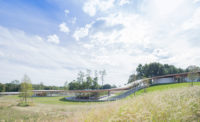New Arc Platform Aims to Streamline and Integrate Green Certification for Existing Buildings

Scot Horst, Chief Product Officer at U.S. Green Building Council
Photo © Architectural Record

Gretchen Sweeney, VP, LEED Implementation at U.S. Green Building Council (left) and Melissa Baker, Director, Technical Business Development at U.S. Green Building Council (right)
Photo © Architectural Record

Gretchen Sweeney, Melissa Baker, and Gautami Palanki, Director at U.S. Green Building Council
Photo © Architectural Record



At Greenbuild 2016, the U.S. Green Building Council (USGBC) and the Green Business Certification Inc. (GBCI) announced a new platform to measure the performance of existing structures and track incremental improvements. Arc, as it’s called, is intended both for buildings that are actively working toward LEED certification under its existing building rating system and those that are not.
Using this new tool, architects and designers will be able to record data about any building, at any point on the sustainability spectrum, and arc will calculate the performance score. “Previously, you had to be earning LEED credits to be part of the system,” said Gretchen Sweeney, vice president of LEED Implementation at the USGBC, speaking at Greenbuild. Scot Horst, USGBC’s chief product officer, who will become arc CEO at the end of this year, told record by phone, “We want to allow everyone to be a part of this ecosystem."
Horst, who has long been focused on transforming LEED from a design tool into a performance metric, compares the rating system to the gym. “The way we had it set up is, you’ve got to lose a certain amount of weight before you get a gym membership. You can only get in and get healthy if you’ve already lost weight,” he said. “What we’re saying now is that we want everyone in the gym—it’s just that, once you lose a certain amount of weight, we’re going to recognize you in a different way.”
Additionally, arc will eventually allow project teams to see how LEED standards overlap with those of other green certification systems, starting with those under GBCI’s purview such as WELL, SITES, and PEER. “We came back to the core of LEED,” said Melissa Baker, USGBC technical business development director, “—the intent behind the credits that actually drives the behavioral change and drives the actions that you take.”
By showing architects and designers how close LEED credits have taken them to achieving other certifications, Baker said, “I think it will drive that desire to really push and do a little bit more.”
Arc will officially launch by the end of 2016, with full integration slated for the middle of 2017.


